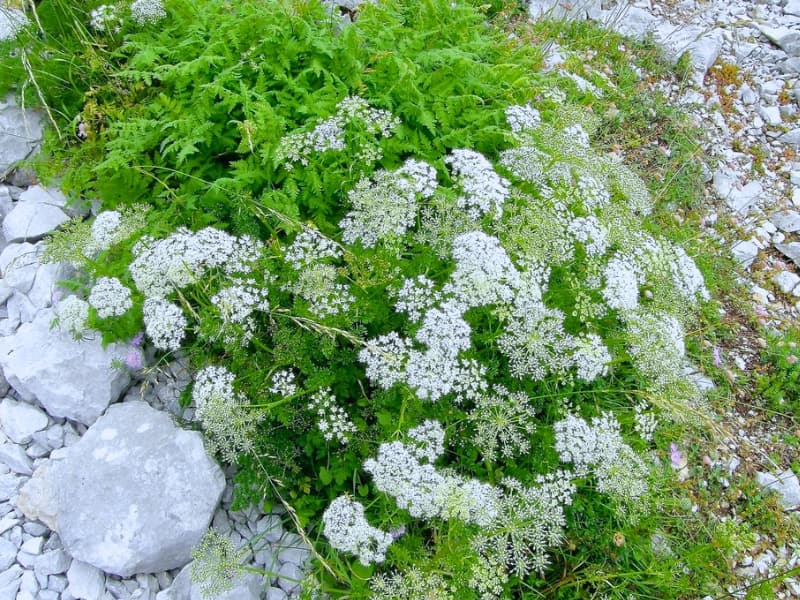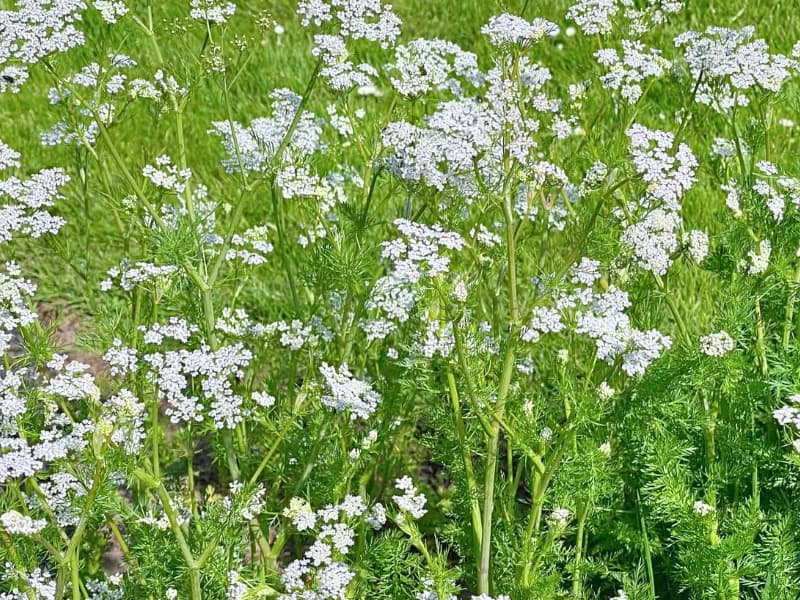Anise Plant, also known by its common names aniseed and sweet cumin, and scientifically as Pimpinella anisum, is a delightful herb with a distinctive licorice-like flavor. This versatile plant has been used for centuries in culinary applications, traditional medicine, and even as a natural fragrance.
At Gardencenterpoint.com, we believe in empowering gardeners with the knowledge to cultivate their own thriving gardens. This comprehensive guide will delve into everything you need to know about the Anise plant, from planting and care to harvesting and utilizing its flavorful seeds and leaves. Prepare to be captivated by the magic of this incredible herb – keep reading to uncover a world of flavor and wellness with detailed instructions of growing anise plants, comparison of different types of anise plants or seeds.

Anise Plant: Botany, History, and Uses
The anise plant, Pimpinella anisum, is an annual herb belonging to the Apiaceae family, which also includes carrots, celery, and parsley. Native to the eastern Mediterranean region and Southwest Asia, it has a long history of cultivation, dating back at least 4,000 years to ancient Egypt. Egyptians used anise for medicinal purposes, as evidenced by its mention in the Ebers Papyrus, an ancient medical text from around 1550 BC. The Romans also valued anise, using it to flavor cakes and as a digestive aid.
| Common Name | Anise, Aniseed, Sweet Cumin |
| Botanical Name | Pimpinella anisum |
| Family | Apiaceae |
| Genus | Pimpinella |
| Species | anisum |
| Origin | Eastern Mediterranean region, Southwest Asia |
| Native | Not native to the USA, but widely naturalized |
| Life Cycle | Annual |
| Plant Type | Herb |
| Hardiness Zone | USDA Zones 4-9 (best grown as an annual in cooler zones) |
| Sunlight | Full Sun (at least 6 hours of direct sunlight per day) |
| Maintenance | Low to Moderate |
| Water | Moderate (keep soil consistently moist, but not waterlogged) |
| Drainage | Well-Drained |
| Spacing | Seeds: 1/4 inch deep, 12 inches apart; Seedlings: thin to 6-8 inches apart |
| Flowering Period | Summer (typically July-August, depending on climate and planting time) |
| Height | 18-24 inches (45-60 cm) on average |
| Growth Rate | Moderate |
| Flower Color | White (small flowers in umbels) |
| Stem Color | Green |
| Flower Benefit | Attracts pollinators (bees, butterflies); essential for seed production |
| Garden Style | Herb Garden, Kitchen Garden, Cottage Garden |
| Uses | Culinary (spice, flavoring), Medicinal (digestive aid, expectorant), Aromatherapy, Insect Repellent |
| Soil pH | 6.0-7.5 (slightly acidic to slightly alkaline) |
| Soil Type | Loamy, well amended with organic matter. |
| Fertilizer | Not a heavy feeder. Balanced fertilizer at planting. |
| Propagation | Primarily by seed. |
| Pest | Relatively pest resistant. Can be affected by Aphids, Spider mites, and whiteflies. |
| Disease | Susceptible to powdery mildew and root rot in humid condition. |
| Toxicity | Generally considered safe for humans. Avoid large amount of essential oil. |
Anise plants typically grow to a height of 18 to 24 inches (45-60 cm) and feature delicate, feathery leaves and small, white flowers that bloom in umbels (umbrella-like clusters). The plant’s most prized part is its small, crescent-shaped seeds, which possess the characteristic licorice flavor. This flavor comes from anethole, an organic compound also found in fennel and star anise (though star anise is a completely different plant, Illicium verum).
The uses of anise are incredibly diverse:
- Culinary: Anise seeds are a popular spice in baking (breads, cookies, cakes), confectionery, and savory dishes. They are also used to flavor liqueurs like anisette, ouzo, pastis, and sambuca. Anise leaves can be used fresh in salads or as a garnish.
- Medicinal: Anise has a long history of use in traditional medicine. It is believed to have carminative (relieving gas), antispasmodic (reducing muscle spasms), and expectorant (promoting the clearing of mucus) properties. A 2017 study published in the “Journal of Evidence-Based Complementary & Alternative Medicine” found that anise seed extract may be effective in relieving symptoms of irritable bowel syndrome (IBS). Another study, published in 2014, showed an anti fungal activity of the Pimpinella anisum essential oil.
- Aromatherapy: Anise essential oil is used in aromatherapy for its calming and uplifting effects.
- Other: Anise are also used as an insect repellent.
The applications of anise in various industries demonstrate its remarkable versatility. This makes understanding its cultivation even more crucial for those seeking to harness its full potential. In a study, the antifungal activity of Pimpinella anisum fruit essential oils against dermatophytes in comparison to griseofulvin was investigated. The MIC (minimal inhibitory concentration) of anise oil was found to be effective and comparable to that of griseofulvin, a common antifungal medication.
| Microorganism | Anise Oil MIC (µg/mL) | Griseofulvin MIC (µg/mL) |
| Trichophyton rubrum | 62.5 | 31.25 |
| Trichophyton mentagrophytes | 125 | 62.5 |
| Microsporum canis | 31.25 | 15.63 |
| Epidermophyton floccosum | 125 | 62.5 |

Growing Anise Plant
Growing anise successfully requires understanding its specific needs. It thrives in warm climates with plenty of sunlight and well-drained soil.
Choosing the Right Location and Soil
- Sunlight: Anise needs at least six hours of direct sunlight per day. Choose a location in your garden that receives ample sun.
- Soil: Anise prefers well-drained, fertile soil with a pH between 6.0 and 7.5. If your soil is heavy clay, amend it with compost or other organic matter to improve drainage. A soil test is highly recommended to determine the pH and nutrient levels.
- Spacing: Sow seeds about ¼ inch (0.6 cm) deep and 12 inches (30 cm) apart. Thin seedlings to 6-8 inches (15-20 cm) apart once they have a few sets of true leaves.
Sowing Anise Seeds
- Timing: Anise is best sown directly in the garden after the last frost. The soil temperature should be at least 60°F (15°C) for optimal germination. In cooler climates, you can start seeds indoors 6-8 weeks before the last expected frost.
- Sowing: Sow seeds thinly and cover them lightly with soil. Water gently and keep the soil consistently moist until germination, which usually takes 10-14 days.
- Transplanting (If Starting Indoors): If using a seed starter, make sure that the seedling mix is lightly watered to germinate the seeds. Once all danger of frost has passed, you can transplant them outdoors,
Watering and Fertilizing
- Watering: Water anise regularly, especially during dry periods. Keep the soil consistently moist but not waterlogged. Avoid overhead watering, which can promote fungal diseases.
- Fertilizing: Anise is not a heavy feeder. A single application of a balanced fertilizer at planting time is usually sufficient. You can also side-dress with compost tea or a diluted fish emulsion fertilizer during the growing season.
Pest and Disease Management
- Pests: Anise is relatively pest-resistant, but it can occasionally be affected by aphids, spider mites, or whiteflies. Insecticidal soap or neem oil can be used to control these pests.
- Diseases: Anise is susceptible to fungal diseases like powdery mildew and root rot, especially in humid conditions or poorly drained soil. Ensure good air circulation and avoid overwatering to prevent these diseases.
Harvesting Anise
- Leaves: You can harvest anise leaves anytime during the growing season. Snip them off with scissors as needed.
- Seeds: Harvest anise seeds when they turn brown, usually in late summer or early fall. Cut the flower heads off the plant and place them in a paper bag. Hang the bag upside down in a cool, dry place. The seeds will dry and fall into the bag.
Troubleshooting Common Anise Growing Problems
Even with the best care, you may encounter some challenges when growing anise. Here are some common problems and their solutions:
- Poor Germination: Old seeds, cold soil temperatures, or insufficient moisture can cause poor germination. Use fresh seeds, ensure the soil is warm enough, and keep it consistently moist.
- Leggy Seedlings: Leggy seedlings are often caused by insufficient light. If starting seeds indoors, provide supplemental light with grow lights.
- Yellowing Leaves: Yellowing leaves can indicate overwatering, underwatering, nutrient deficiencies, or pest infestations. Check the soil moisture, fertilize if needed, and inspect for pests.
- Powdery Mildew: This fungal disease appears as a white, powdery coating on the leaves. Improve air circulation, avoid overhead watering, and apply a fungicide if necessary.
- Bolting: Bolting is a term to describe a plant when it flowers and goes to seed prematurely. Anise is sensitive to temperature. Heat stress may cause bolting.
Comparing Different Types of Anise and Similar Plants
While Pimpinella anisum is the true anise, there are other plants with similar flavors or names that are often confused with it:
- Star Anise (Illicium verum): This is a completely different plant, native to China and Vietnam. It produces star-shaped fruits with a similar licorice flavor, but it is much stronger than anise. Star anise is not related to anise and belongs to a different family (Schisandraceae).
- Fennel (Foeniculum vulgare): Fennel is a close relative of anise, belonging to the same family (Apiaceae). It has a similar licorice flavor, but it is milder and sweeter. Fennel bulbs are often used as a vegetable, while the seeds and leaves are used as a spice.
- Anise Hyssop (Agastache foeniculum): Another plant that is often confused with Anise, Anise Hyssop has a licorice scent. It is a member of the mint family.
| Feature | Anise (Pimpinella anisum) | Star Anise (Illicium verum) | Fennel (Foeniculum vulgare) | Anise Hyssop (Agastache foeniculum) |
| Family | Apiaceae | Schisandraceae | Apiaceae | Lamiaceae |
| Part Used | Seeds, leaves | Fruits | Bulbs, seeds, leaves | Leaves, Flowers |
| Flavor | Licorice-like | Strong licorice-like | Mild, sweet licorice-like | Licorice-like |
| Origin | Eastern Mediterranean | China, Vietnam | Mediterranean | North America |
| Plant type | Annual | Evergreen Tree | Perennial | Perennial |

Propagating Anise Plant
Anise is primarily propagated from seed. While it’s possible to propagate it from cuttings, it’s less common and often less successful. Seed propagation is straightforward and reliable, as described in the “Growing Anise Plant” section above. The best way is to collect the seeds once the plants are dried, and store in a dry, cool, dark place until it is time to plant in the spring.
Using and Storing Anise
Once you’ve harvested your anise, you’ll want to use it and store it properly to preserve its flavor and aroma.
- Using Fresh Anise Leaves: Fresh anise leaves can be added to salads, soups, stews, or used as a garnish. They have a milder flavor than the seeds.
- Using Anise Seeds: Anise seeds can be used whole or ground. Toasting the seeds before grinding enhances their flavor. Add them to baked goods, desserts, savory dishes, or beverages.
- Storing Anise Seeds: Store whole anise seeds in an airtight container in a cool, dark, and dry place. They will retain their flavor for up to two years. Ground anise loses its flavor more quickly, so it’s best to grind it just before use.
- Storing Anise Leaves: Fresh anise leaves can be stored in the refrigerator for a few days, wrapped in a damp paper towel and placed in a plastic bag.
Anise Plant and its Health Benefits
Beyond its culinary uses, anise offers several potential health benefits.
- Digestive Aid: As mentioned earlier, anise has a long history of use as a digestive aid. It can help relieve gas, bloating, and indigestion. The anethole in anise is believed to stimulate digestive enzymes.
- Respiratory Health: Anise may help relieve coughs and congestion due to its expectorant properties. It can help loosen mucus and make it easier to cough up.
- Antimicrobial Properties: Some studies have shown that anise essential oil has antimicrobial activity against certain bacteria and fungi.
- Menopausal Symptoms: Some research suggests that anise may help relieve hot flashes and other symptoms of menopause. A 2018 study in the Journal of Caring Sciences found Anise to reduce hot flashes.

Leave a Reply